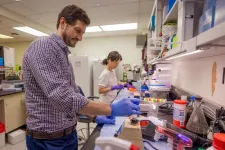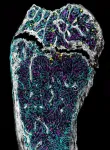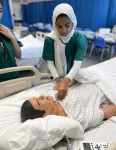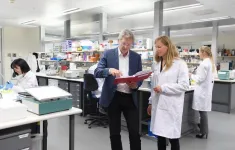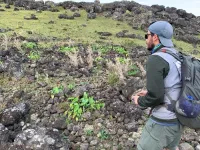(Press-News.org) The link between severe headache disorders headaches and the body’s circadian clock in pain timing and thresholds will be studied with a $2.4 million grant from the National Institute of Neurological Disorders and Stroke (NINDS) to UTHealth Houston researchers.
The research is led by two faculty members of McGovern Medical School at UTHealth Houston: Mark Burish, MD, PhD, associate professor in the Vivian L. Smith Department of Neurosurgery, and Seung-Hee Yoo, PhD, associate professor in the Department of Biochemistry and Molecular Biology.
The study builds on earlier research by Burish and Yoo, funded by the Will Erwin Headache Research Foundation and published in 2023 in the journal Neurology, which revealed that both cluster headache and migraine are strongly linked to the internal clock that regulates body processes known as the circadian system. Burish and Yoo became interested in the topic of circadian clock regulation in headaches due to the clear circadian feature from cluster headache patients.
Cluster headache, which affects 1 in 1,000 people, is an extremely painful disorder that carries a higher risk of suicidality than the general population and can severely impact a patient’s quality of life. In the previous research, Burish and Yoo found that there was a circadian pattern of cluster headache attacks in more than 70% of participants, with a peak between 9 a.m. and 3 p.m., and seasonal peaks in spring and autumn.
“Both migraine and cluster headache, but cluster headache in particular, have an unusually circadian pattern of attacks,” Yoo said. “And several of the treatments for cluster headache and migraine, like steroids and melatonin, strongly influence the core molecular machinery of our body’s internal clock. We thought that these links were interesting. With Dr. Burish’s background in headaches and my background in circadian biology, we started to discuss new ways to study the circadian features of headaches.”
In a pre-clinical study by the team recently published in Headache, Yoo and Burish found a new circadian pattern of pain in a laboratory headache mouse model that involved nitroglycerin, a medication that can trigger cluster headaches and migraines in those patients. When the clock genes were genetically altered in this laboratory model, the circadian pattern of pain disappeared. Burish and Yoo believe this research, which was years in development through funding by the Will Erwin Headache Research Foundation, holds promise as a new model for studying the unusually circadian nature of these headaches.
“The circadian aspect of cluster headache and migraine are fascinating – something seems to get activated at the same time every day,” Burish said. “A goal of our research is to understand that activation, with the hopes of someday preventing these headaches from occurring. We are grateful to the Will Erwin Headache Research Foundation for giving us the type of long-term support needed to explore a new field of research, and are very happy to have now received funding from the NIH.”
Burish is also the director of the Will Erwin Headache Research Center at UTHealth Houston Neurosciences. Yoo and Burish are faculty members in The University of Texas MD Anderson Cancer Center UTHealth Houston Graduate School of Biomedical Sciences.
The grant number for the award from NINDS, part of the National Institutes of Health, is R01NS136677-01.
END
Circadian clock impact on cluster headaches funded by $2.4M NIH grant for UTHealth Houston research
2024-06-21
ELSE PRESS RELEASES FROM THIS DATE:
Study identifies first drug therapy for sleep apnea
2024-06-21
Researchers at University of California San Diego School of Medicine and international collaborators have led a worldwide, advanced study demonstrating the potential of tirzepatide, known to manage type 2 diabetes, as the first effective drug therapy for obstructive sleep apnea (OSA), a sleep-related disorder characterized by repeated episodes of irregular breathing due to complete or partial blockage of the upper airway.
The results, published in the June 21, 2024 online edition of New England Journal of Medicine, highlight the treatment’s potential to improve the quality of life for millions around the world affected by OSA.
“This study marks a significant ...
How old is your bone marrow?
2024-06-21
Our bone marrow—the fatty, jelly-like substance inside our bones—is an unseen powerhouse quietly producing 500 billion new blood cells every day. That process is driven by hematopoietic stem cells that generate all of the various types of blood cells in our bodies and regenerating themselves to keep the entire assembly line of blood production operating smoothly.
As with any complex system, hematopoietic stem cells lose functionality as they age—and, in the process, contribute to the risk of serious diseases, including blood cancers. We know that the risk of developing aging-associated diseases is different among different individuals. ...
Boosting biodiversity without hurting local economies
2024-06-21
DURHAM, N.C. -- Protected areas, like nature reserves, can conserve biodiversity without harming local economic growth, countering a common belief that conservation restricts development. A new study outlines what is needed for conservation to benefit both nature and people.
Conservation zones aim to preserve biodiversity, protect endangered species, and maintain natural habitats. “There’s long been uncertainty about the economic tradeoffs,” said Binbin Li, associate professor of environmental science at Duke Kunshan University, and lead author ...
ChatGPT is biased against resumes with credentials that imply a disability — but it can improve
2024-06-21
While seeking research internships last year, University of Washington graduate student Kate Glazko noticed recruiters posting online that they’d used OpenAI’s ChatGPT and other artificial intelligence tools to summarize resumes and rank candidates. Automated screening has been commonplace in hiring for decades. Yet Glazko, a doctoral student in the UW’s Paul G. Allen School of Computer Science & Engineering, studies how generative AI can replicate and amplify real-world biases — such as those against disabled people. How might such a system, she wondered, rank resumes that implied someone had a disability?
In ...
Simple test for flu could improve diagnosis and surveillance
2024-06-21
Fewer than one percent of people who get the flu every year get tested, in part because most tests require trained personnel and expensive equipment. Now researchers have developed a low-cost paper strip test that could allow more patients to find out which type of flu they have and get the right treatment.
The test, developed by a team from the Broad Institute of MIT and Harvard and Princeton University, and supported by the US Centers for Disease Control and Prevention, uses CRISPR to distinguish between the two main types of seasonal flu, influenza A and B, as well as seasonal ...
UT Health San Antonio researcher awarded five-year, $2.53 million NIH grant to study alcohol-assisted liver disease
2024-06-21
SAN ANTONIO, June 21, 2024 – Liver transplants associated with alcohol-related disease are growing at a rapid pace, shifting research to address pathologies behind the ailments in light of a limited supply of organ donors.
At the forefront is Mengwei Zang, MD, PhD, an internationally recognized leader in chronic liver disease research at The University of Texas Health Science Center at San Antonio (UT Health San Antonio) who was just awarded a groundbreaking five-year, $2.53 million grant from the National ...
Giving pre-med students hands-on clinical training
2024-06-21
A group of pre-medical students received valuable hands-on clinical training during a workshop in the new Smart Hospital at The University of Texas at Arlington.
The Clinical Experience Workshop allowed 10 pre-med students to participate in experiential activities and to interact one-on-one with “patients” portrayed by students from the UTA Department of Theatre Arts.
“This was a clinical opportunity for pre-med students with no clinical background to be immersed in clinical medicine, learn basic skills, and experience actual patient encounters with simulated patients ...
CAMH research suggests potential targets for prevention and early identification of psychotic disorders
2024-06-21
A new study by the Centre for Addiction and Mental Health (CAMH), entitled Mental Health Service Use Before First Diagnosis of a Psychotic Disorder and published in JAMA Psychiatry, found that nearly 75 per cent of young Ontarians with a psychotic disorder had at least one mental health service visit within the three years prior to their first diagnosis of the disorder.
The retrospective cohort study—one of the largest of its kind—suggests that youth with a psychotic disorder are nearly four times as likely to have a previous mental health-related hospital ...
Mapping the heart to prevent damage caused by a heart attack
2024-06-21
Scientists at the Victor Chang Cardiac Research Institute in Australia have produced a first of its kind integrated map of heart cells which unlocks the process of cardiac fibrosis – a major cause of heart failure.
The discovery opens new avenues to develop targeted drugs to prevent scarring damage caused after a heart attack.
During and after a heart attack, the heart’s muscles are damaged leading to the formation of scar tissue which lacks the elasticity and contractility of healthy heart muscle. This damage is permanent and can affect ...
Study challenges popular idea that Easter islanders committed ‘ecocide’
2024-06-21
Some 1,000 years ago, a small band of Polynesians sailed thousands of miles across the Pacific to settle one of the world’s most isolated places—a small, previously uninhabited island they named Rapa Nui. There, they erected hundreds of “moai,” or gigantic stone statues that now famously stand as emblems of a vanished civilization. Eventually, their numbers ballooned to unsustainable levels; they chopped down all the trees, killed off the seabirds, exhausted the soils and in the end, ruined their environment. Their population and civilization collapsed, with just a few thousand people remaining when ...
